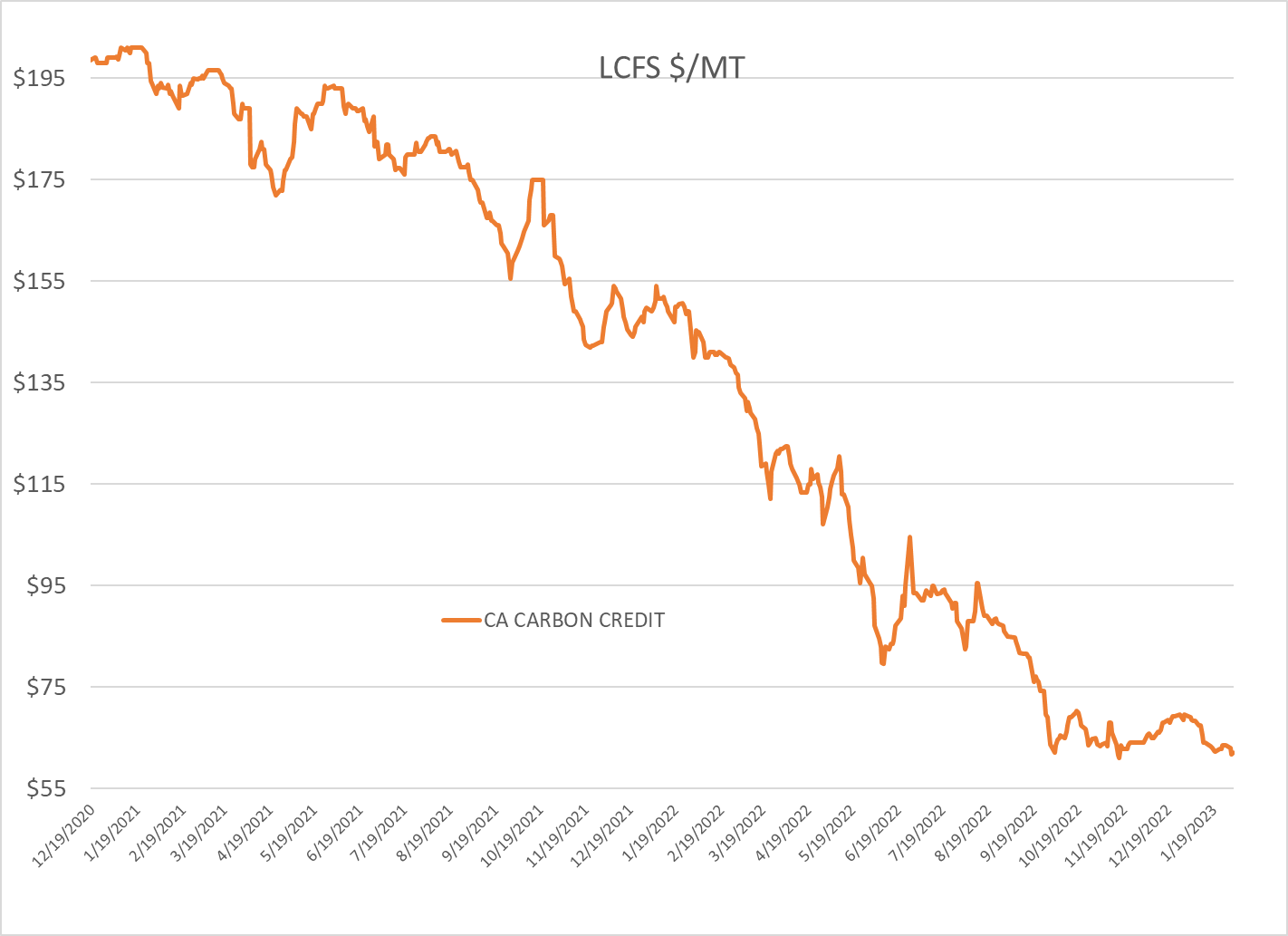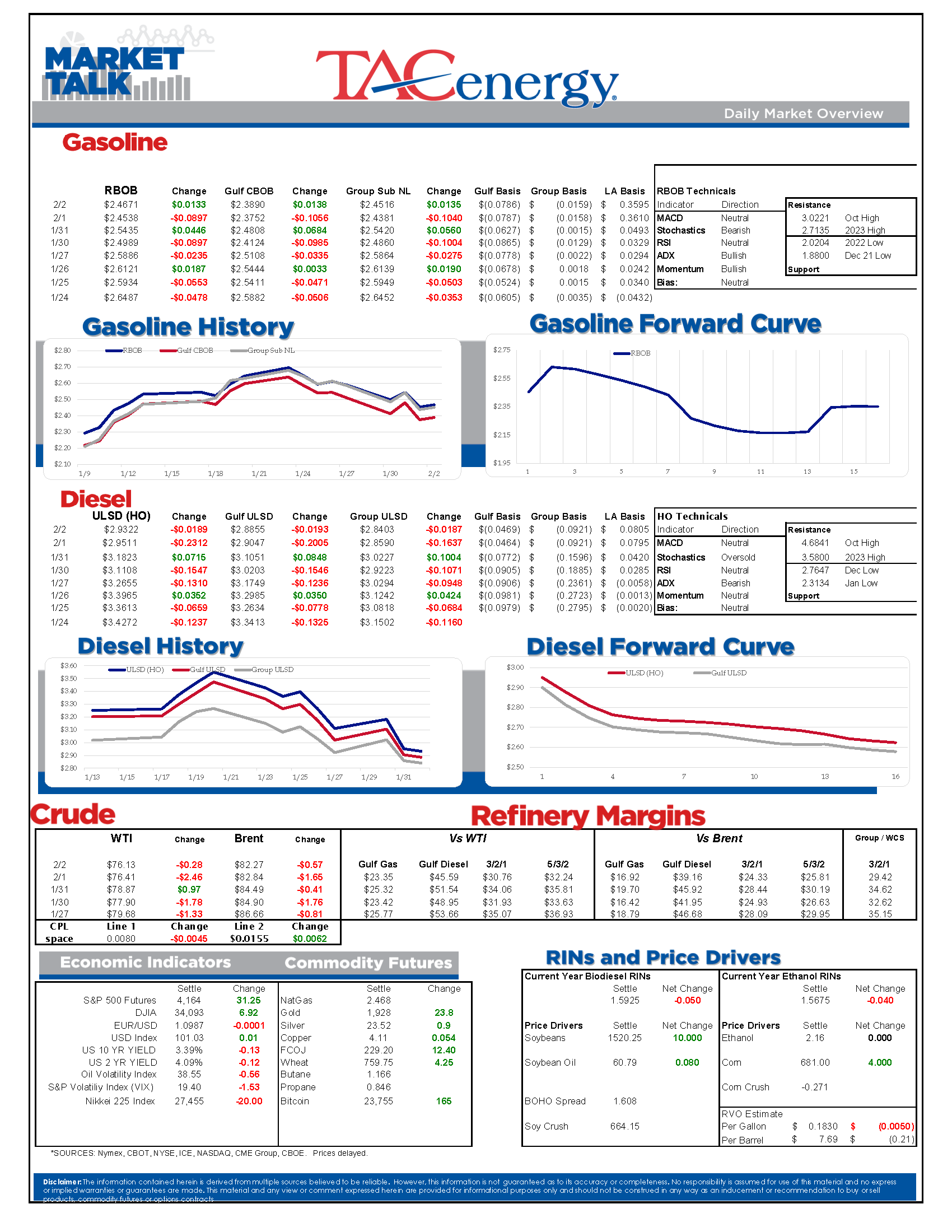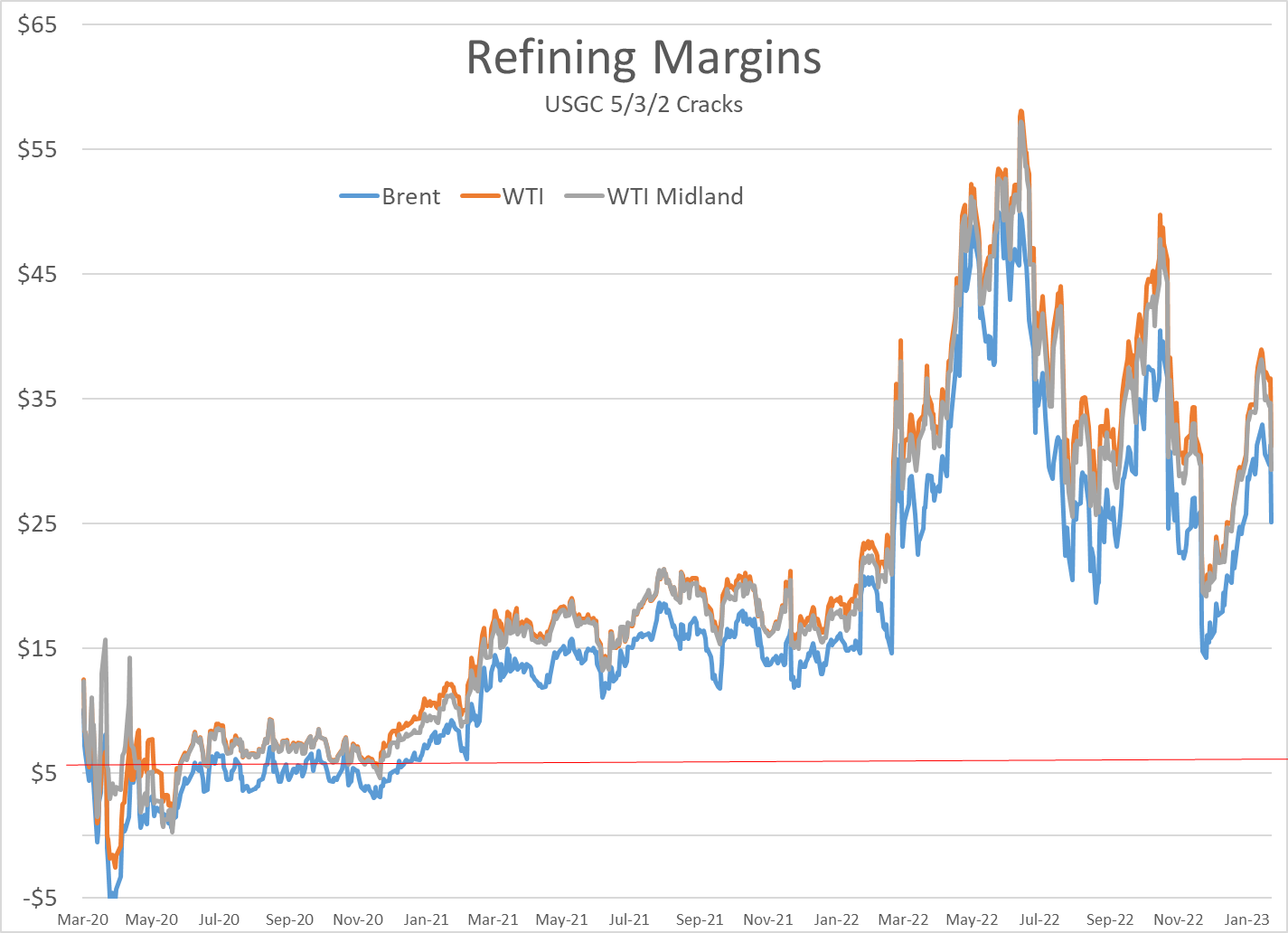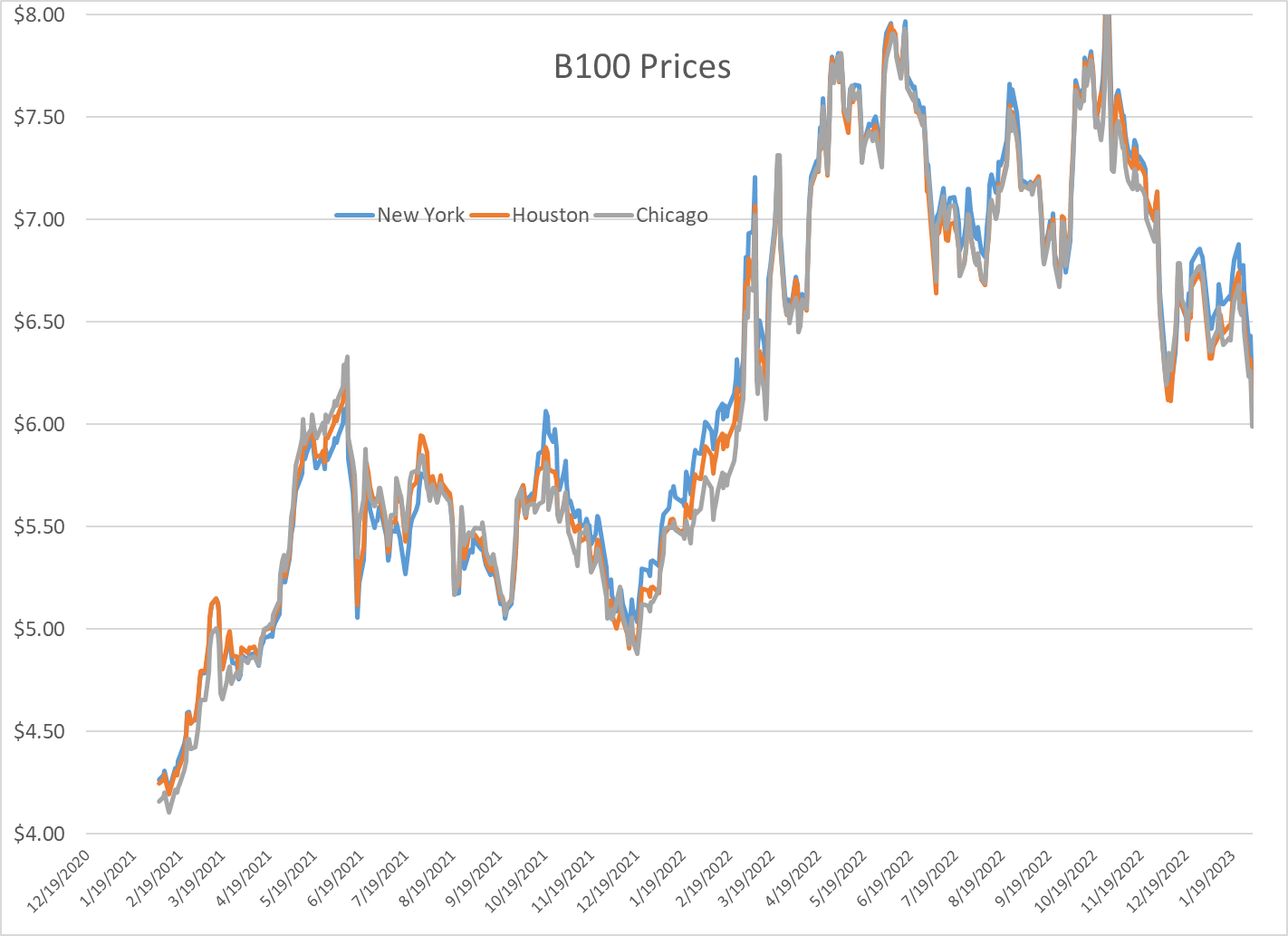Diesel Prices Collapse, Return To December Levels

Diesel prices led another big wave of selling to start February trading Wednesday and are following through with lower prices again this morning. A combination of bearish technical and fundamental factors seem to be at play with the plunging diesel prices that have wiped out half of the impressive gains in refining margins since prices bottomed out 2 months ago.
The move also came despite a big drop in the US dollar and surging equity prices after the Fed Chair’s press conference Wednesday which was apparently viewed through rose colored glasses by the easy money crowd.
It took 12 trading days for ULSD prices to rally from $2.92 to $3.58 in January, but just 6 to give all 66 cents back. Sellers wasted little time once the weekly trendlines broke Wednesday completing the cycle and pushing prices right back to the $2.92 range. This sets up a potentially pivotal test for the balance of the week, with a break and hold below the January lows setting the stage for a run at the December lows of $2.76, while a hold here could set up a period of sideways trading within the confines of the January range.
B100 prices have also dropped around 70 cents/gallon over the past week as bio blends race lower to stay competitive with the sudden drop in diesel prices. Adding to the challenge for bio-blenders that sell a $6 fuel in a $3 diesel market are RIN values that have seen their first significant selling in 2 months, lowering the subsidy for blending those fuels, while LCFS credits remain stuck in the low $60s which is less than 1/3 of where they were 2 years ago.
Speaking of government subsidies influence on bio-fuels, the largest renewable diesel producer in the US announced plans to shift direction and make its next major investment in Sustainable Aviation Fuels as the latest blenders tax credit package offers up to a 75 cent advantage for SAF blenders vs RD and Biodiesel, while all 3 fuels will be competing for the same feedstocks.
Refinery runs dipped last week as a large reduction in PADD 5 (west coast) runs offset a large increase in PADD 2 (Midwest). The PADD 5 run rate fell to a 2 year low following several unplanned events coinciding with the annual spring maintenance season as facilities tool up to produce summer grade gasoline. We had already seen San Francisco spot gasoline differentials jump nearly 40 cents/gallon over the past week, and LA spots followed suit Wednesday, jumping to a 3-month high north of 36 cents over futures.
The DOE’s weekly report showed inventories continuing to build despite the dip in refinery runs, with distillate demand the ugly number on the week. Even though diesel inventories remain uncomfortably low across most regions, days of supply are approaching average levels thanks to a very weak start to the year for diesel consumers. There’s no doubt that unseasonably warm winter weather on the East Coast (prior to this weekend anyway) has contributed to that weak demand, and the weeks of rain on the West Coast certainly didn’t help, but gauging the market’s reaction, there’s also some fear that the slump in diesel demand is an indicator of slowing economic activity.
Gasoline demand meanwhile saw a healthy increase for a 3rd straight week, but continues to hold below the 5-year average, and has only outpaced 2022 numbers 1 out of 4 weeks so far this year. Gasoline exports remain near the top end of their 5-year range, while distillate exports have been steady near the 5-year average so far this year. The severe weather that swept the gulf coast refinery zone may have limited the exports over the past two weeks however, so don’t be surprised to see a big drawdown if there’s a backlog of ships that clears in February.
More bad news for Colorado. Yesterday the Suncor refinery reported a leak, which is impressive considering it hasn’t been operating since the Christmas blizzard, which will no doubt add time and headaches to their repair process. Then overnight the P66 refinery in Borger TX, which has pipeline access to supply Colorado, was said to shut units for at least the 3rd time since being damaged by that same storm.
Latest Posts
Week 15 - US DOE Inventory Recap
Prices To Lease Space On Colonial’s Main Gasoline Line Continue To Rally This Week
Equity Markets Have Been Pulling Back Sharply In Recent Days As Inflation And Trade Concerns Inject A Sense Of Reality Into Stocks
Gasoline And Crude Oil Prices Reached Fresh Multi-Month Highs Friday Morning As News Of The Anticipated Attacks Spread
Social Media
News & Views
View All
Week 15 - US DOE Inventory Recap

Prices To Lease Space On Colonial’s Main Gasoline Line Continue To Rally This Week
Energy markets are sliding lower again to start Wednesday’s trading as demand concerns and weaker stock markets around the world seem to be outweighing any supply concerns for the time being.
Rumors continue to swirl about an “imminent” response by Israel to Iran’s attacks, but so far, no news seems to be taken as good news in the hopes that further escalation can be avoided, even as tensions near the Red Sea and Strait of Hormuz continue to simmer.
Prices to lease space on Colonial’s main gasoline line continue to rally this week, trading north of 11 cents/gallon as Gulf Coast producers still struggle to find outlets for their production, despite a healthy export market. Gulf Coast CBOB is trading at discounts of around 34 cents to futures, while Gulf Coast RBOB is trading around a 16-cent discount, which gives shippers room to pay up for the linespace and still deliver into the East Coast markets at a profit.
Back to reality, or just the start of more volatility? California CARBOB basis values have dropped back to “only” 40 cent premiums to RBOB futures this week, as multiple flaring events at California refineries don’t appear to have impacted supply. The state has been an island for fuel supplies for many years as its boutique grades prevent imports from neighboring states, and now add the conversion of the P66 Rodeo refinery to renewable diesel production and the pending changes to try and cap refinery profits, and it’s easier to understand why these markets are increasingly vulnerable to supply shocks and price spikes on gasoline.
RIN prices continue to fall this week, touching 44 cents/RIN for D4 and D6 values Tuesday, their lowest level in 6 weeks and just about a nickel above a 4-year low. While the sharp drop in RIN and LCFS values has caused several biodiesel and Renewable Diesel producers to either shut down or limit production, the growth in RIN generation continues thanks to projects like the Rodeo refinery conversion, making the supply in RINs still outpace the demand set by the Renewable Fuel Standard by a wide margin.
The API reported draws in refined products, 2.5 million barrels for gasoline and 427,000 barrels for distillates, while crude oil stocks had an estimated build of more than 4 million barrels. The DOE’s weekly report is due out at its normal time this morning.
Click here to download a PDF of today's TACenergy Market Talk.

Equity Markets Have Been Pulling Back Sharply In Recent Days As Inflation And Trade Concerns Inject A Sense Of Reality Into Stocks
It’s a mixed bag for energy markets to start Tuesday’s session with gasoline prices holding small gains, while oil and diesel prices show small losses as the world anxiously debates what comes next in the conflict, we’re still hoping we don’t have to call a war in the Middle East.
An early sell-off picked up steam Monday morning with refined products down more than a nickel for a few minutes, before reports that Israel was vowing to respond to Iran’s attack seemed to encourage buyers step back in an erase most of the losses for the day.
Equity markets have been pulling back sharply in recent days as inflation and trade concerns inject a sense of reality into stocks that had been flying high earlier in the year. The correlation between gasoline and crude oil prices had been fairly strong for the past couple of months but has since weakened as the weakness in stocks hasn’t yet trickled over into the energy arena. Both asset classes are seeing a tick higher in their volatility (aka Fear) indices this week however, and when fear starts driving the trade, we often see these prices move together.
Diesel has been underperforming the rest of the energy complex for most of the year so far, and those hoping for lower diesel prices got more good news when the Dangote refinery in Nigeria began loading diesel for domestic use Monday, in the latest milestone for the giant project that will have a major influence on Atlantic basin supply. Naturally, local lawmakers are already complaining that the refinery’s prices are too high.
The EIA this morning highlighted the record amount of crude oil China imported in 2023 after reopening the country post-COVID and after completing numerous new refinery builds in the past few years. Russia accounted for the largest increase in shipments to China last year, as China is one of the few countries that doesn’t mind ignoring sanctions. Speaking of which, the US House is expected to take up a new vote this week on sanctioning Chinese imports of Iranian crude, which the EIA notes are often hidden by relabeling the crude to make it appear as if it originated in Malaysia, Oman or the UAE.
We’re just 2 weeks away from the startup of Canada’s long-awaited Transmountain pipeline expansion that will bring roughly 600,000 barrels/day of capacity to the Pacific basin. That new outlet is great news for Canadian producers long restricted by takeaway capacity, and bad news for Midcontinent refiners who have grown accustomed to the discounted Canadian grades. A Bloomberg article Monday noted that Iraq’s Basrah Heavy crude is most likely to be displaced by West Coast US refiners who can now buy much closer to home.
Click here to download a PDF of today's TACenergy Market Talk.




